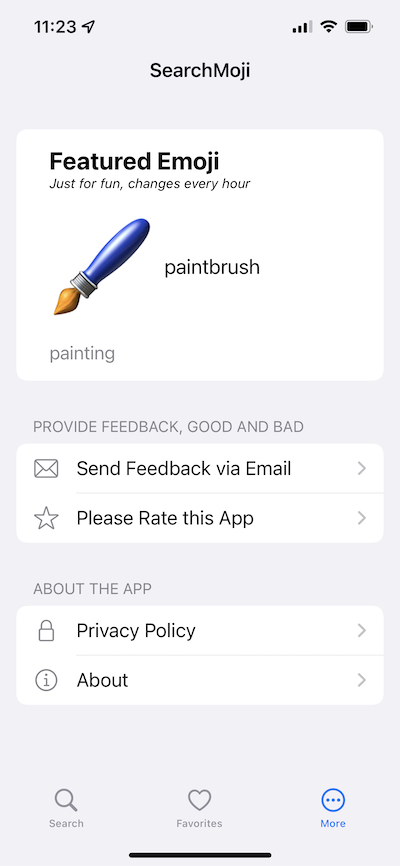SearchMoji Version 2022.3 Released
SearchMoji version 2022.3 has been released in the App Store. This update brings some UI polish with several tweaks made to the app’s Dark Mode support. These adjustments provide a more consistent experience across screens. Screens and table view cells now have consistent background colors.
I also refactored (replaced really) a couple screens to get rid of their .xib implementations. One screen (the “More” screen) was just a table view controller without any custom table view cells, so I simply created an all-programmatic UI with UITableViewController. For another screen (the “About” screen), I started to do the same when I realized a SwiftUI view would work just fine. I actually took the SwiftUI AboutView from the Snaplists app and dropped it in SearchMoji. With minor tweaks to change the displayed app name and logo, the view worked great.
Just for fun, I added a “Featured Emoji” to the More screen. This screen displays options for submitting app feedback, viewing the privacy policy etc. After the app’s re-release to the App Store earlier this year, the screen had a large amount of empty space where the IAP to remove ads used to be (the app no longer has ads). The “Featured Emoji” feature displays a different emoji every hour.
It was fun coming up with how to choose a different emoji each hour to display. Basically, I am calculating the number of hours elapsed since the beginning of the year. Using that number as an index to select an emoji from the list of all emojis (as returned by the app’s search function). There are actually more hours in a year than the number of emojis returned by the search, so the featured emoji will actually wrap around and start over a few times per year.
The code calculating and fetching the featured emoji:
public func fetchFeaturedEmoji() -> SMCEmoji? {
let allEmojis = searchEmojis(searchTerm: "", skinTone: .none)
let emojiCount = allEmojis.count
let now = Date()
guard let interval = Calendar.current.dateInterval(of: .year, for: now) else {
fatalError("Failed to get DateInterval for year.")
}
let comps = Calendar.current.dateComponents([.hour], from: interval.start, to: now)
let hour = comps.hour ?? 42
let multiples = hour / emojiCount
let remainder = hour - (multiples * emojiCount)
guard remainder < emojiCount else {
return nil
}
return fetchEmoji(allEmojis[remainder].name)
}
A few comments on this code:
- The method is
publicbecause it is in the SearchMojiCore framework, which is used by the iOS app target. - The
42is there because.houris of typeInt?. We should always get an hour back and the42should never be used (in my lifetime!). - The
returnstatement is actually calling into another method that returns a more detailed emoji result with all the metadata needed for the UI.
And the featured emoji as seen in the app:

NOTE: I removed this app from the App Store on May 27, 2024. Read about why here.